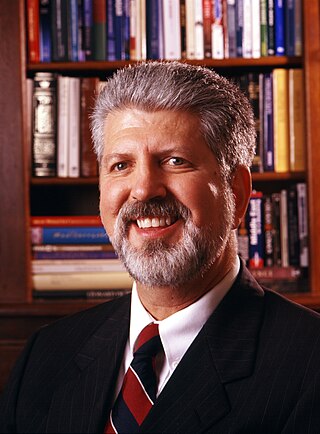Related Research Articles
Psychology is an academic and applied discipline involving the scientific study of human mental functions and behavior. Occasionally, in addition or opposition to employing the scientific method, it also relies on symbolic interpretation and critical analysis, although these traditions have tended to be less pronounced than in other social sciences, such as sociology. Psychologists study phenomena such as perception, cognition, emotion, personality, behavior, and interpersonal relationships. Some, especially depth psychologists, also study the unconscious mind.

Abraham Harold Maslow was an American psychologist who created Maslow's hierarchy of needs, a theory of psychological health predicated on fulfilling innate human needs in priority, culminating in self-actualization. Maslow was a psychology professor at Brandeis University, Brooklyn College, New School for Social Research, and Columbia University. He stressed the importance of focusing on the positive qualities in people, as opposed to treating them as a "bag of symptoms". A Review of General Psychology survey, published in 2002, ranked Maslow as the tenth most cited psychologist of the 20th century.
Transpersonal psychology, or spiritual psychology, is an area of psychology that seeks to integrate the spiritual and transcendent human experiences within the framework of modern psychology.
Logotherapy is a form of existential therapy developed by neurologist and psychiatrist Viktor Frankl. It is founded on the premise that the primary motivational force of individuals is to find meaning in life. Frankl describes it as "the Third Viennese School of Psychotherapy" along with Freud's psychoanalysis and Alfred Adler's individual psychology.
In psychology, schizotypy is a theoretical concept that posits a continuum of personality characteristics and experiences, ranging from normal dissociative, imaginative states to extreme states of mind related to psychosis, especially schizophrenia. The continuum of personality proposed in schizotypy is in contrast to a categorical view of psychosis, wherein psychosis is considered a particular state of mind, which the person either has or does not have.

Links between creativity and mental health have been extensively discussed and studied by psychologists and other researchers for centuries. Parallels can be drawn to connect creativity to major mental disorders including bipolar disorder, autism, schizophrenia, major depressive disorder, anxiety disorder, OCD and ADHD. For example, studies have demonstrated correlations between creative occupations and people living with mental illness. There are cases that support the idea that mental illness can aid in creativity, but it is also generally agreed that mental illness does not have to be present for creativity to exist.
The God gene hypothesis proposes that human spirituality is influenced by heredity and that a specific gene, called vesicular monoamine transporter 2 (VMAT2), predisposes humans towards spiritual or mystic experiences. The idea has been proposed by geneticist Dean Hamer in the 2004 book called The God Gene: How Faith is Hardwired into our Genes.
A spectrum disorder is a disorder that includes a range of linked conditions, sometimes also extending to include singular symptoms and traits. The different elements of a spectrum either have a similar appearance or are thought to be caused by the same underlying mechanism. In either case, a spectrum approach is taken because there appears to be "not a unitary disorder but rather a syndrome composed of subgroups". The spectrum may represent a range of severity, comprising relatively "severe" mental disorders through to relatively "mild and nonclinical deficits".

Grandiose delusions (GDs), also known as delusions of grandeur or expansive delusions, are a subtype of delusion characterized by the extraordinary belief that one is famous, omnipotent, wealthy, or otherwise very powerful or of a high status. Grandiose delusions often have a religious, science fictional, or supernatural theme. Examples include the extraordinary belief that one is a deity or celebrity, or that one possesses fantastical talents, accomplishments, or superpowers.
The Temperament and Character Inventory (TCI) is an inventory for personality traits devised by Cloninger et al. It is closely related to and an outgrowth of the Tridimensional Personality Questionnaire (TPQ), and it has also been related to the dimensions of personality in Zuckerman's alternative five and Eysenck's models and those of the five factor model.

Claude Robert Cloninger is an American psychiatrist and geneticist noted for his research on the biological, psychological, social, and spiritual foundation of both mental health and mental illness. He previously held the Wallace Renard Professorship of Psychiatry, and served as professor of psychology and genetics, as well as director of the Sansone Family Center for Well-Being at Washington University in St. Louis. Cloninger is a member of the evolutionary, neuroscience, and statistical genetics programs of the Division of Biology and Biomedical Sciences at Washington University, and is recognized as an expert clinician in the treatment of general psychopathology, substance dependence, and personality disorders. Dr. Cloninger is currently professor emeritus.
In psychology, novelty seeking (NS) is a personality trait associated with exploratory activity in response to novel stimulation, impulsive decision making, extravagance in approach to reward cues, quick loss of temper, and avoidance of frustration. That is, novelty seeking refers to the tendency to pursue new experiences with intense emotional sensations. It is a multifaceted behavioral construct that includes thrill seeking, novelty preference, risk taking, harm avoidance, and reward dependence.

Reward dependence (RD) is characterized as a tendency to respond markedly to signals of reward, particularly to verbal signals of social approval, social support, and sentiment. When reward dependence levels deviate from normal we see the rise of several personality and addictive disorders.
What was previously known as melancholia and is now known as clinical depression, major depression, or simply depression and commonly referred to as major depressive disorder by many health care professionals, has a long history, with similar conditions being described at least as far back as classical times.
Spiritual crisis is a form of identity crisis where an individual experiences drastic changes to their meaning system typically because of a spontaneous spiritual experience. A spiritual crisis may cause significant disruption in psychological, social, and occupational functioning. Among the spiritual experiences thought to lead to episodes of spiritual crisis or spiritual emergency are psychiatric complications related to existential crisis, mystical experience, near-death experiences, Kundalini syndrome, paranormal experiences, religious ecstasy, or other spiritual practices.
Persistence(PS) is a key personality trait identified by psychiatrist C. Robert Cloninger in his Psychobiological Model of Personality. It describes an individual's propensity to remain motivated, resilient and goal-driven in the face of challenges and difficulties they may encounter whilst carrying out tasks and working towards goals. More precisely, persistence refers to “perseverance in spite of fatigue or frustration”. According to Cloninger, this perseverance demonstrates a psychological determination that is foundational in aiding an individual's long-term success in achieving goals.
Most scientists agree that religiosity is not an independent personality trait, despite there being some commonality between their characteristics. Religiosity and personality traits both relate to one's feelings, thoughts, and behaviors. However, unlike for personality, one's level of religiosity is often measured by the presence or lack of belief in and relationship with a higher power, certain lifestyles or behaviors adopted for a higher power, and a sense of belonging with other followers of one's religion. Additionally, personality traits tend to follow a normal distribution, such that the majority of individuals' scores for a personality trait will be concentrated towards the middle, rather than being extremely high or low. Distributions for religiosity, however, follow a non-normal distribution, such that there are more individuals who score particularly high or low on religiosity scales.
Self-directedness is a personality trait held by someone with characteristic self-determination, that is, the ability to regulate and adapt behavior to the demands of a situation in order to achieve personally chosen goals and values.
Cooperativeness is a personality trait that concerns how much a person is generally agreeable in their relations with other people as opposed to aggressively self-centered and hostile.
The alternative five factor model of personality is based on the claim that the structure of human personality traits is best explained by five broad factors called impulsive sensation seeking (ImpSS), neuroticism–anxiety (N-Anx), aggression–hostility (Agg-Host), sociability (Sy), and activity (Act). The model was developed by Marvin Zuckerman and colleagues as a rival to the well-known five factor model of personality traits and is based on the assumption that "basic" personality traits are those with a strong biological-evolutionary basis. One of the salient differences between these two models is that the alternative five model lacks any equivalent to the dimension called openness to experience in the five factor model.
References
- ↑ De Fruyt, F.; Van De Wiele, L.; Van Heeringen, C. (2000). "Cloninger's Psychobiological Model of Temperament and Character and the Five-Factor Model of Personality". Personality and Individual Differences. 29 (3): 441–452. doi:10.1016/S0191-8869(99)00204-4.
- 1 2 Cloninger, C.R.; Svrakic, D.M.; Przybeck, T.R. (December 1993). "A psychobiological model of temperament and character". Archives of General Psychiatry. 50 (12): 975–90. doi:10.1001/archpsyc.1993.01820240059008. PMID 8250684.
- ↑ Frankl, Viktor E. (1966). "Self-transcendence as a human phenomenon". Journal of Humanistic Psychology. 6 (2): 97–106. doi:10.1177/002216786600600201. S2CID 144208833.
- ↑ Koltko-Rivera, Mark E. (2006). "Rediscovering the later version of Maslow's hierarchy of needs: Self-transcendence and opportunities for theory, research, and unification" (PDF). Review of General Psychology. 10 (4): 302–317. doi:10.1037/1089-2680.10.4.302. S2CID 16046903.
- ↑ Reed, P. G. (1991). "Toward a nursing theory of self-transcendence: Deductive reformulation using developmental theories". Advances in Nursing Science. 13 (4): 64–77. doi:10.1097/00012272-199106000-00008. PMID 2059006. S2CID 2099622.
- 1 2 3 4 5 MacDonald, D.A.; Holland, D. (2002). "Examination of the psychometric properties of the temperament and character inventory self-transcendence dimension". Personality and Individual Differences. 32 (6): 1013–1027. doi:10.1016/S0191-8869(01)00107-6.
- ↑ Reed, Pamela G. (1991). "Self-transcendence and mental health in oldest-old adults". Nursing Research. 40 (1): 5–11. doi:10.1097/00006199-199101000-00002. PMID 1987557. S2CID 37939669.
- ↑ Levenson, Michael R.; et al. (2005). "Self-transcendence: Conceptualization and measurement". The International Journal of Aging and Human Development. 60 (2): 127–143. doi:10.2190/XRXM-FYRA-7U0X-GRC0. PMID 15801386. S2CID 35589606.
- ↑ Frankl, Viktor E. (2014) [1969]. The will to meaning: Foundations and applications of logotherapy. Penguin.
- ↑ Reed, P. G. (2003). "The theory of self-transcendence". In Smith, M. J.; Liehr, P. (eds.). Middle range theories in nursing. New York, N.Y.: Springer. p. 147.
- ↑ Maslow, A. H. (1969). Various meanings of transcendence. J. Transpers. Psychol. 1, 56–66, at 59.
- ↑ Koenig, Harold G. (2008). "Concerns About Measuring 'Spirituality' in Research". The Journal of Nervous and Mental Disease. 196 (5): 349–55. doi:10.1097/NMD.0b013e31816ff796. PMID 18477877. S2CID 30273892.
- ↑ Harley, James A.; Wells, J. Elisabeth; Frampton, Christopher M. A.; Joyce, Peter R. (2011). "Bipolar Disorder and the TCI: Higher Self-Transcendence in Bipolar Disorder Compared to Major Depression". Depression Research and Treatment. 2011: 1–6. doi: 10.1155/2011/529638 . PMC 3140026 . PMID 21789279.
- ↑ MA, Courtney E. Ackerman (4 June 2018). "What is Self-Transcendence? Definition and 6 Examples (+PDF)". PositivePsychology.com. Retrieved 28 February 2024.
- ↑ Harley, James A.; Wells, J. Elisabeth; Frampton, Christopher M. A.; Joyce, Peter R. (2011). "Bipolar Disorder and the TCI: Higher Self-Transcendence in Bipolar Disorder Compared to Major Depression". Depression Research and Treatment. 2011: 1–6. doi: 10.1155/2011/529638 . PMC 3140026 . PMID 21789279.
- ↑ Harley, James A.; Wells, J. Elisabeth; Frampton, Christopher M. A.; Joyce, Peter R. (2011). "Bipolar Disorder and the TCI: Higher Self-Transcendence in Bipolar Disorder Compared to Major Depression". Depression Research and Treatment. 2011: 1–6. doi: 10.1155/2011/529638 . PMC 3140026 . PMID 21789279.
- ↑ Margetić, Branka Aukst; Jakovljević, Miro; Ivanec, Dragutin; Margetić, Branimir (2011). "Temperament, character, and quality of life in patients with schizophrenia and their first-degree relatives". Comprehensive Psychiatry. 52 (4): 425–30. doi:10.1016/j.comppsych.2010.08.007. PMID 21683179.
- ↑ Andrew Sims. "Is Faith Delusion?" (PDF). Archived from the original (PDF) on 2020-11-01.
- ↑ Koenig HG, McCullough ME & Larson DB (2001) Handbook of Religion and Health. Oxford University Press.